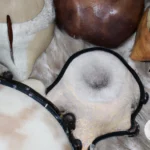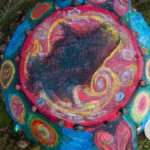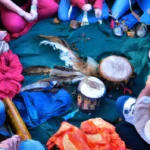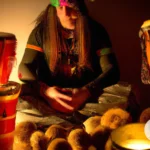The sound of a shamanic drumbeat can transport us to another realm, evoke deep emotions, and even heal our bodies and minds. Through centuries of shamanic practice, the drum has been a foundational tool used by shamans to connect with spirits, embark on journeys, and facilitate healing. In this article, we will explore the rich history and significance of drums in shamanic practices across cultures, the various techniques and styles used in shamanic drumming, and the therapeutic power of this ancient tradition. Join us on a journey through the rhythm and magic of shamanic music.
The History and Significance of Drums in Shamanic Practices
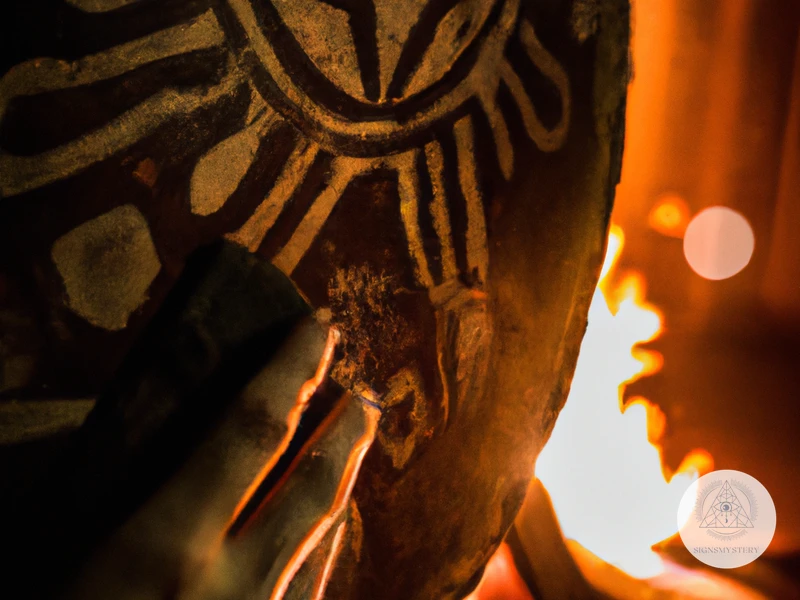
Drums are one of the most important and sacred instruments in shamanic practices. The history of using drums in shamanism dates back thousands of years and is closely tied to the spiritual beliefs of many cultures around the world. Indigenous cultures from Africa to North and South America have developed their own unique drumming traditions that have been passed down through generations. In shamanic practices, the drum is considered a powerful tool for connecting with the spiritual realm and altering consciousness. The steady beat of the drum is believed to help induce a trance state that allows the shaman to journey into the spirit world. The drum itself is often considered a living being, with its own spirit, and is treated with great respect and care. While other instruments, such as flutes or chimes, are also used in shamanic practice, it is the drum that remains the foundation of the shaman’s journey.
The Shamanic Drumming Tradition Across Different Cultures
The use of drums in shamanic practices has a long and rich history that spans across many cultures around the world. Here are some examples of the shamanic drumming tradition in different parts of the world:
| Region | Drumming Tradition |
|---|---|
| Africa | The Djembe drum is used in West African shamanic practices. The drum is believed to represent the heartbeat of the community and can be used to call forth spirits during rituals. |
| North America | The Native American drumming tradition involves using a large drum that is often made from a hollowed-out tree trunk and drumhead made from animal hide. The drum is used to facilitate communication with the spirit world and to connect with the natural environment. |
| Siberia | The shamanic drumming tradition in Siberia used the frame drum, called the tambourine. It was believed that the spirits of animals lived within the drum, and during a ritual, the shaman was able to communicate with them by playing the drum. |
| South America | In South America, the shamanic drumming tradition involves using the ayahuasca drum. The drum is believed to be a powerful tool for accessing altered states of consciousness during ayahuasca ceremonies. |
Despite the differences in drumming traditions across cultures, there are some commonalities. For example, the drum is often considered to be a powerful tool for communicating with spirits, accessing altered states of consciousness, and facilitating healing. The significance of other musical instruments, such as flutes, rattles, gongs, and chimes, also varies across different shamanic cultures.
The Role of Drums in the Shaman’s Journey
Drums have played a significant role in shamanic practices for centuries. The rhythmic beat of the drum is believed to induce a trance-like state in the shaman, allowing them to journey to other realms and communicate with spirits. In many shamanic traditions, the drum is considered to be the shaman’s most important tool, as it allows them to access altered states of consciousness and connect with the spiritual realm.
The drumming is performed in a specific way that helps the shaman to reach the desired state of consciousness. The consistent tempo of the drumming serves as a kind of auditory anchor or guidepost, helping the shaman to navigate the spiritual realm and stay connected to the present moment. The sound of the drum is also believed to carry spiritual energy, which can help to clear blockages and bring healing to the shaman.
Shamanic drumming is often performed in groups as well, with multiple drummers playing in perfect synchronization. This creates a powerful energy field that can amplify the effects of the drumming and help the shamans to journey deeper into the spiritual realm. In some cultures, the drumming is accompanied by chanting or singing, adding to the overall intensity of the experience.
The journey itself can take many forms depending on the tradition and the shaman’s intention. Some shamans use drumming to connect with animal spirits, while others use it to communicate with ancestors or spiritual guides. The experience can be both ecstatic and transformative, leaving the shaman with a deeper understanding of themselves and their place in the world.
The role of drums in the shaman’s journey is crucial. The powerful and rhythmic beat of the drum serves as a bridge between the physical and spiritual worlds, allowing the shaman to communicate with spirits and access altered states of consciousness. Whether performed individually or in groups, shamanic drumming is a powerful tool for personal growth and transformation.
Drumming Techniques and Styles in Shamanic Music
Drumming is the primary aspect of shamanic music, and it plays an essential role in the shaman’s journey to altered states of consciousness. There are several drumming techniques and styles used in shamanic music that contribute to achieving these altered states.
Steady Rhythms
One of the most critical drumming techniques in shamanic music is the use of steady rhythms. The drummers maintain a constant and repetitive beat, which helps the shaman enter a trance-like state. The steady rhythms act as an anchor, creating a stable and safe environment for the shaman’s journey.
Call and Response
Call and response is another drumming technique used in shamanic music. This technique involves a lead drummer starting a rhythm and another drummer joining in with a complementary pattern. This creates a dialogue between the two drummers, with one leading and the other responding. The call and response technique can be used to signal the start and end of a shamanic journey.
Layering
Layering is a drumming technique that involves playing different rhythms on top of each other. This technique adds complexity and depth to the music, creating a rich and immersive experience. The layering technique can also help the shaman travel to different realms by providing a range of frequencies.
Improvization
Improvisation is a style of drumming used in shamanic music, which involves playing by feel rather than adhering to a set pattern or rhythm. Improvisation can add an organic, unpredictable element to shamanic music, creating new and unique experiences every time. The shaman may use improvisation to respond to the energies they encounter on their journey.
Drumming Styles
There are also various drumming styles used in shamanic music, including frame, Bodhrán, and Taiko drums, to name a few. The frame drum is the most commonly used shamanic drum, but different cultures and traditions use other types of drums. Each drum produces a unique sound, and the style of drumming complements the shaman’s journey.
Drumming techniques and styles are crucial components of shamanic music. Steady rhythms, call and response, layering, and improvisation all contribute to achieving the altered states necessary for a shamanic journey. The different drumming styles also provide a variety of sounds and experiences, making shamanic music a diverse and rich form of expression.
The Therapeutic Power of Shamanic Drumming
The therapeutic power of shamanic drumming is a well-known aspect of shamanic practices. The repetitive rhythms and vibrations produced by the drumming help to induce a state of trance, which can be therapeutic for a variety of physical and mental health issues. In fact, studies have shown that shamanic drumming can be effective in reducing stress, anxiety, and depression, as well as in managing pain. The therapeutic benefits of shamanic drumming also extend to the spiritual realm, as it can be used to facilitate spiritual journeys and connect practitioners with their inner selves. Shamanic drumming is a powerful tool for healing and self-discovery, and has been used by shamans and holistic healers for centuries.
Shamanic Drumming as a Healing Practice
Shamanic drumming has been used as a powerful healing practice for centuries. It is believed that the sound and vibrations produced by the drum can penetrate deep into
Subscribe to Our Newsletter
Sign up to receive the latest news and updates.
| Benefits of Shamanic Drumming for Healing: |
|---|
| Reduces Stress and Anxiety: Shamanic drumming creates a peaceful and meditative state that allows the body to release stress and tension. Stress is known to be the root cause of many illnesses in the body. Thus, reducing stress levels can promote overall physical and mental well-being. |
| Boosts Immunity: According to research, reducing stress levels through shamanic drumming can help boost immune function. It helps to activate the para-sympathetic nervous system, which helps bring the body back into balance and promotes healing. |
| Alleviates Pain: Drumming also stimulates the production of endorphins, the body’s natural painkillers, which can help alleviate pain and promote relaxation. |
| Emotional Healing: Shamanic drumming can also help with emotional healing by releasing negative emotions and trauma stored deep within the body. It promotes positive feelings of connection, well-being, and self-awareness. |
Shamanic drumming as a healing practice is not limited to physical and emotional well-being. It is believed that it can also help connect one’s spiritual self, and build a deeper connection with one’s higher power. It can help with spiritual growth and a deeper sense of purpose in life.
Shamanic drumming is a simple yet powerful practice that can be easily incorporated into one’s daily routine to promote health and well-being in all aspects of life.
Benefits of Shamanic Drumming
The benefits of shamanic drumming are numerous and have been recognized by many cultures for centuries. Here are some of the most important benefits of this therapeutic practice:
| Benefits | Description |
|---|---|
| Relaxation and Stress Relief | Shamanic drumming helps reduce stress and promote relaxation. The repetitive drumming sound has a soothing effect on the mind and body, allowing the listener to enter a state of deep relaxation and calm. |
| Increased Focus and Mindfulness | Drumming requires concentration and focus, which helps improve mindfulness and awareness. Regular drumming practice can enhance cognitive function and improve overall brain health. |
| Emotional Healing | The rhythmic beating of the drum can help release emotional blockages, allowing the listener to access and process deep-seated emotions. Shamanic drumming has been used as a therapeutic tool for emotional healing and trauma release. |
| Physical Healing | Shamanic drumming has been proven to have a positive effect on physical health. The stimulation of the nervous system and the release of endorphins can help alleviate pain and improve immune function. |
| Spiritual Growth | Drumming can be a spiritual experience that can enhance one’s connection to the divine and promote personal growth. It can help individuals access deeper levels of consciousness and gain spiritual insights. |
Shamanic drumming is a powerful therapeutic practice that can offer a range of physical, emotional, and spiritual benefits. Whether practiced alone or in a group, the rhythmic beating of the drum can have a profound and transformative effect on the mind, body, and soul.
Conclusion
As we have explored in this article, the role of drums in shamanic music is fundamental to the shamanic journey. Across different cultures, we have seen the tradition of shamanic drumming being used to access altered states of consciousness and connect with spiritual realms. The rhythms and techniques used in shamanic drumming are unique to each culture, but they all serve the same purpose of inducing trance-like states.
The therapeutic power of shamanic drumming is undeniable. Its ability to reduce stress, anxiety, and promote relaxation makes it a valuable tool in modern healing practices. Shamanic drumming sessions have been known to induce feelings of euphoria, deep insight, and spiritual connectedness.
In conclusion, the drum is an integral part of shamanic music and has a significant role in the shamanic journey. The techniques and styles used in shamanic drumming have been passed down through generations and continue to be used in diverse cultures around the world. The healing and therapeutic benefits of shamanic drumming make it a valuable tool in modern times. So, whether you are a shaman, a musician, or a music lover, the role of drums in shamanic music is sure to inspire and captivate you.
Frequently Asked Questions
What are shamanic drums made of?
Shamanic drums are typically made of wood frames with animal hides stretched over them.
Can anyone play a shamanic drum?
Yes, anyone can play a shamanic drum, but it is important to approach it with respect and intention.
What is the significance of the drum in shamanic journeying?
The drum is the most common tool used by shamans for journeying and can help create a trance-like state needed for accessing other realms and receiving guidance.
Can shamanic drumming be used for physical healing?
Yes, shamanic drumming has been used as a form of healing in many cultures, both for physical and emotional healing.
What is the difference between shamanic drumming and other types of drumming?
Shamanic drumming is often slower and repetitive, with a specific rhythm that helps induce a trance-like state.
Do different cultures have different types of shamanic drumming?
Yes, different cultures have unique styles and rhythms of shamanic drumming, but the basic principles and intent remain the same.
Can shamanic drumming be used for personal spiritual practice?
Yes, shamanic drumming can be a powerful tool for personal spirituality, meditation, and connecting with the spirit world.
What is the benefit of shamanic drumming in modern times?
Shamanic drumming can help reduce stress, improve focus, and promote overall wellness in modern times.
What should I do to prepare for a shamanic drumming session?
It is important to set an intention, create a comfortable space free of distractions, and have a willingness to surrender to the experience.
How can I learn more about shamanic drumming?
There are many resources available, including workshops, online courses, and books on the subject. It is important to find a reputable teacher or source of information.



